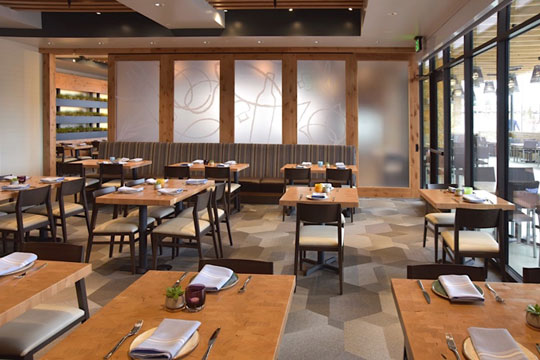Chinese Food Islamabad: Take Pleasure In Genuine Chinese Cuisine at its Best
Chinese Food Islamabad: Take Pleasure In Genuine Chinese Cuisine at its Best
Blog Article
Savor Genuine Eastern Cuisine With a Pan-Asian Spin for a Cooking Adventure
Getting started on a cooking journey through genuine Asian cuisine, improved with a Pan-Asian twist, offers a distinct possibility to discover the abundant tapestry of flavors that specify the region's varied culinary traditions. As you consider these enticing recipes, think about the cultural narratives and historic impacts that shape them, each bite providing a story waiting to be uncovered. Best ambiance restaurants Islamabad.

Checking Out Pan-Asian Tastes
In the realm of worldwide gastronomy, Pan-Asian cuisine stands out for its impressive variety and the harmonious interaction of tastes from different Oriental cultures. This culinary technique celebrates the special ingredients and rich practices located throughout the continent, creating a tapestry of tastes that is both rewarding and fascinating. Key to Pan-Asian food is its capacity to stabilize different tastes-- sweet, salted, spicy, and sour-- while highlighting the freshness and quality of each ingredient.
From the umami-rich soy sauce of Japan to the fiery chili peppers of Thailand, Pan-Asian food provides a substantial combination of tastes. These aspects are usually integrated in innovative methods, enhancing recipes with layers of intricacy. For example, the use of great smelling herbs such as lemongrass and cilantro, typical in Vietnamese and Thai food, includes a refreshing brightness to dishes, while the incorporation of coconut milk provides a luscious, abundant appearance.
The focus on fresh produce and aromatic seasonings makes certain that each meal is not only a feast for the palate yet also for the senses. Pan-Asian food invites restaurants to get started on a cooking journey, discovering the substantial and varied landscapes of Asian gastronomy with every bite.
Fusion Meals to Attempt
While Pan-Asian cuisine is commemorated for its traditional flavors, the modern culinary landscape is increasingly welcoming combination meals that blend these traditional components with influences from various other regions. This innovative technique not only honors the abundant heritage of Oriental cooking arts but also presents novel taste experiences that attract contemporary tastes buds.
An archetype of such a blend dish is the Korean-Mexican taco, where marinated bulgogi beef is covered in a warm tortilla, topped with kimchi and a spicy gochujang-infused salsa. This combination marries the vibrant, tasty tastes of Korea with the vivid, fresh aspects of Mexican food. In a similar way, sushi burritos have obtained appeal, amalgamating the delicate artistry of Japanese sushi with the hearty, hand-held comfort of a burrito, commonly including combination components like tempura shrimp and avocado with a drizzle of wasabi mayo.
Another significant meal is Thai curry ramen, which instills the velvety, fragrant flavors of Thai curry into the comforting broth of conventional Japanese ramen, producing a harmonious blend that entices the senses. These fusion recipes prolong beyond mere novelty; they represent a culinary discussion between societies, encouraging exploration and development on the planet of Pan-Asian cuisine.
Important Components and Flavors
To truly appreciate Pan-Asian food, one have to understand the necessary ingredients and flavors that develop its foundation. This diverse cooking style draws from a rich tapestry of Oriental customs, employing an unified blend of tastes and textures. Key active ingredients consist of soy sauce, fish sauce, and oyster sauce, which impart a tasty umami depth vital to Eastern dishes. Corresponding to these are rice vinegar and mirin, providing a fragile acidity and sweetness.
Aromatic components are critical, with garlic, lemongrass, and ginger being ubiquitous across different Pan-Asian dishes. These components offer an aromatic base that boosts the intricacy of tastes. Seasonings such as star anise, cardamom, and cinnamon introduce heat and personality, resembling influences from regions like China and India.

Food Preparation Methods and Tips
Mastering the art of Pan-Asian cuisine needs familiarity with its unique cooking techniques, each adding to the dynamic tapestry of flavors this cooking custom is commemorated for. Central to these methods is the stir-fry, a rapid cooking strategy that preserves the dietary stability and vivid colors of active see here ingredients. Making use of a frying pan, the stir-fry method permits even heat circulation, necessary for achieving the characteristic texture and flavor balance of Pan-Asian dishes.
One more basic technique is steaming, specifically widespread in Chinese food. This gentle technique maintains the natural tastes and nutrients of components, making it perfect for fish and shellfish and vegetables. Dumplings, a beloved staple, frequently gain from steaming, causing soft, delicious appearances.
Grilling, likewise integral, presents great smoky midsts to dishes such as Korean bulgogi or Japanese yakitori (Best ambiance restaurants Islamabad). This method often includes marinading active ingredients, permitting flavors to permeate deeply before cooking over an open flame or warmer
Last but not least, mastering the art of stabilizing flavors-- pleasant, sour, salty, bitter, and umami-- is essential. Correctly layering these aspects can raise a recipe from common to extraordinary, offering a complicated and satisfying cooking experience that personifies the essence of Pan-Asian food.
Dining Experiences Worldwide
Throughout the world, Pan-Asian cuisine supplies an unmatched eating experience, celebrated for its abundant tapestry of flavors and dynamic presentations. This culinary sensation has actually gone beyond cultural borders, recording you can try here the hearts and tastes buds of food fanatics worldwide. In multicultural cities fresh York, London, and Sydney, Pan-Asian restaurants function as fusions where culinary practices from Thailand, Japan, China, and past assemble, supplying diners with an eclectic mix of recipes that highlight the region's variety.
The worldwide charm of Pan-Asian cuisine hinges on its capability to provide both credibility and development. Cooks masterfully marry standard components such as lemongrass, soy sauce, and miso with modern techniques, resulting in recipes that are both familiar and refreshingly new. This combination allows restaurants to get started on a cooking trip that appreciates heritage while accepting modernity.
Moreover, eating experiences are raised via thoughtfully designed atmospheres that mirror the ethos of Pan-Asian appearances. From minimalist Japanese-inspired interiors to dynamic Thai-themed areas, each dining establishment supplies an one-of-a-kind ambiance that matches the culinary offerings. Therefore, patrons are not just eating a dish but partaking in a cultural experience, making Pan-Asian eating a truly international phenomenon.
Final Thought
The expedition of Pan-Asian cuisine supplies a profound understanding of the detailed interplay of tastes and cooking customs across Asia. By embracing blend recipes such as Thai curry ramen and sushi burritos, the culinary trip not only highlights the flexibility see here of typical active ingredients yet also showcases innovative modern strategies. This gastronomic journey, enhanced by essential flavors and cooking techniques, supplies a special possibility to appreciate the multiculturalism and cooking creativity that specify Pan-Asian food on an international range.
Getting started on a culinary journey with genuine Asian food, enhanced with a Pan-Asian twist, uses an one-of-a-kind opportunity to check out the rich tapestry of flavors that define the region's varied culinary practices.In the realm of international gastronomy, Pan-Asian cuisine stands out for its impressive variety and the unified interaction of flavors from different Oriental societies. Trick to Pan-Asian food is its capacity to balance contrasting tastes-- sweet, salty, spicy, and sour-- while highlighting the freshness and quality of each ingredient.

Report this page